CHIS Streetscape- paving
Maggie Shapland
Patent Impervious Paving, S Westminster Chambers, SW- to be seen along Royal York Crescent
Streetscape- the term which describes all that one sees in a street in addition to buildings, such as pavements, street furniture, traffic and other signs. Whereas attention is often paid to preserving buildings, especially in Conservation Areas, the streetscape is often overwhelmed by unecessary clutter and poor workmanship.
Contents on this web page
- Princess Victoria Street Flagstones
- Gloucester Street Cobbles
- Cobblestone Mews
- Patent Impervious Paving
- Utility Cover
- Pennant Flagstones
- PETITION - FOOTWAY MATERIALS
- Cobbles and flag stones
- Features which need to be protected
- Useful websites:
Princess Victoria Street Flagstones
Feb 2015:
Workmen when replacing broken flagstones, repaired pennant flag stones of the mews houses much to our relief, to maintain the character of the area
Gloucester Street Cobbles
Feb 2015: Gas works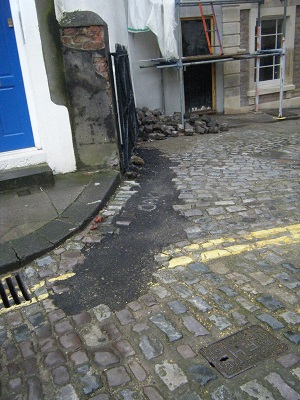
Tarmac and big heap of cobbles left for several days |
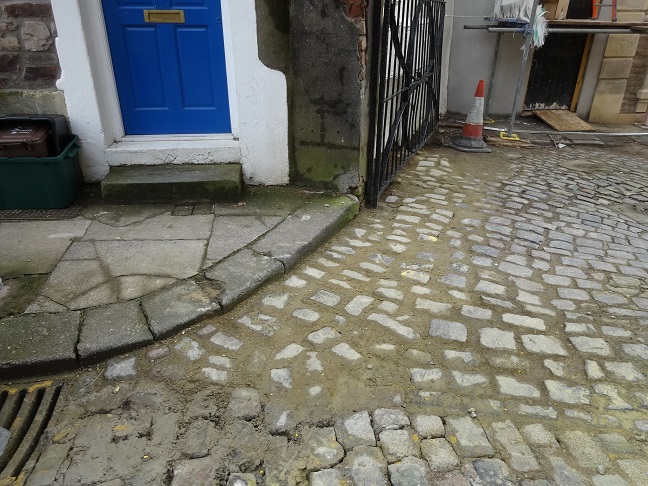
Cobbles relaid, but then had to be relaid after inspection |
Cobblestone Mews
30 Sept 2013: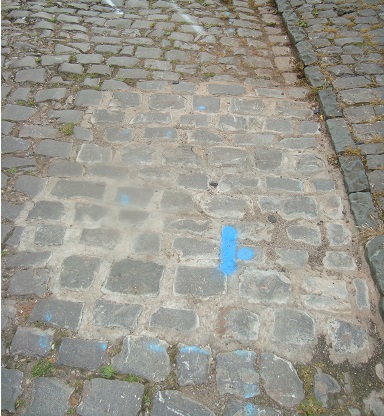
Obtrusive mortar stood out |

Cobbles being laid back with unobtrusive mortar. Really tidy job. Thank you Bristol Water and Rossco Civil Engineering! |
16 September 2013:
Email from Diane Cox,
Operational Customer Adviser of Bristol Water:
Thank you for your emails of 10 and 13 September regarding work carried out in Cobblestone Mews on behalf of Bristol Water.
I can appreciate your concerns over the preservation of the cobbles at this location and I am happy that you are pleased with the reinstatement of the road surface. We always do our best to reinstate to the original condition of any area where excavation is required.
Your kind comments are much appreciated. I have sent a copy of your email to our Renovations Manager, who will in turn contact the relevant crew to pass on your compliment. Thank you once again for taking the trouble to write in.
If you have any questions about this e-mail please contact me on 0845 7023797, 8.30am to 4.30pm Monday to Friday, or through our e-mail address Customer.services@bristolwater.co.uk. For future reference, our Code of Practice for Operational Enquiries and Complaints can be found on our website.
Bristol Water plc
PO Box 218, Bridgwater Road | Bristol | BS99 7AU | United Kingdom
Email customer.services@bristolwater.co.uk | Web http://www.bristolwater.co.uk
11 Sept 2013:
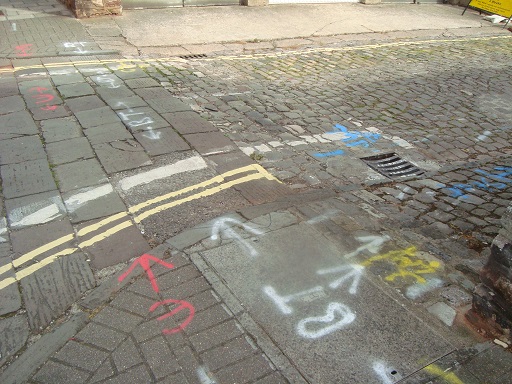
utility marks (blue water, yellow gas, white BT, red electricty |
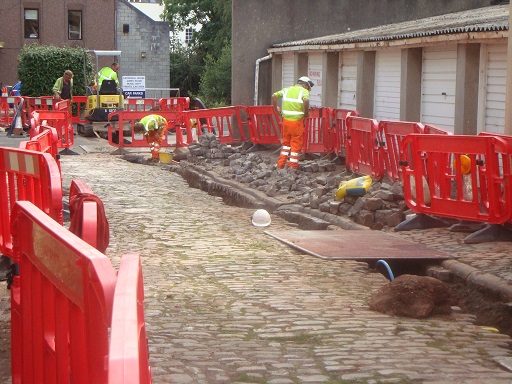
cobbles being dug up |
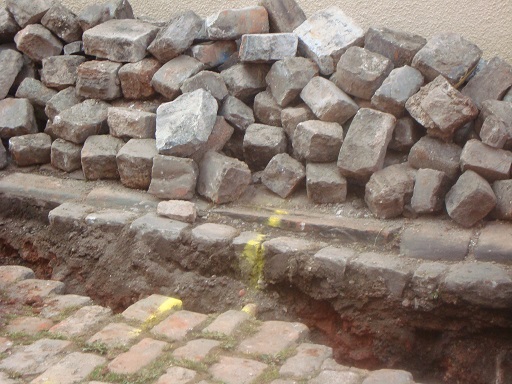
big heap of cobbles |

total cobbled street (with cast iron lamp posts still lit by gas) |
We were alerted by a CHIS member "Is anybody doing anything to prevent the destruction of Cobblestone mews one of the few remaining cobbled streets in Clifton? BTís contractors are there now and have started to tear it up. He spoke to one of the workmen who said that the cobbles were in such terrible broken up condition already that they could not save many for putting back."
We took photos and contacted the conservation department, the enforcement department and our Councillor. We saw that there was a glorious miscellany of blue, yellow and grey lines relating to the different utilities. Roadworks in Bristol website was useful to find more details.
http://bristol.roadworks.org/ gives a map of Bristol roadworks
- Enforcement told us: "I can confirm that telecoms and water providers are able to undertake any works for their purpose under Part 10 of the T and C P (GPDO). There are no controls over how they make good their works. I note your concerns over loss of cobbled finished highway so have copied in Phil Cotham from our Highways Team. The best intervention would probably come directly from a local amenity society requesting that all the cobblestones are replaced following completion of works."
- The conservation department tried to get someone to go out and check this out/ get them to do it properly if appropriate before its too late. This is a really important and intact historic street where we need to make sure they do it well.
- We then contacted Bristol Water on 0800 783 2812 (blue lines) who said they would contact me back after speaking to the contractors. They needed to know the postcode and wanted to know the contractors. They confirmed they normally replace cobbles.
- We contacted BT on 0800 023 2023 (grey lines) who told me to find the Dial to dig website but confirmed they had not done any work in the street for 15 years
- We also contacted British Gas 0800 0725 230 (yellow lines) who told me to go and speak to the contractor and find out his details and ring them back.
- I then spoke to the contractors armed with the Clifton Conservation Area Appraisal in which we put in a photo of the Mews, confirming how important that traditional surface treatments should be preserved because they preserve the character of the street. This was particularly salient here due to the name of the street! They were very helpful and confirmed the cobbles would be relaid, they would replace broken cobbles, use a darker mortar so that it would not stand out. They also asked me to ask the Council to see if the had some spare cobbles in their yard so that the colour of replacement cobbles would match better. They had put all the different coloured lines to indicate the locations of the different utilities. It did not mean each company would come along in quick succession and rip up each others work.
Patent Impervious Paving
At the beginning of June 2013, we noticed that the pavement outside 8-9 Royal York Crescent was being replaced (maintenance of raised pavements are the responsibility of the owners of the properties, not of the Council). Many of the owners have used stone slabs which are more fitting than black asphalt. Clearly if the pavement is faulty, damp seeps into the courtyard area below the terrace. In winter, saturated brick and limestone freezes and expands and causes substantial damage, so substantially impervious paving is needed above to make rain to flow off the surface into the side drains. This particular stretch of paving had unusual lettering, and I was anxious that it should be retained as part of the historic streetscape of this grade II* terrace.I asked the builders what had happened to the sign, but they had not received any instructions to keep it which worried me, and I warned them that the pavement was listed and features like this could not be removed. Time was of essence since the work was progressing fast, so I contacted the Council Planning Enforcement team, the conservation department, and Charles Lucas our new councillor asking them to help. To their credit, officers visited the site the following morning and met and discussed the matter with the contractors. They were shown the brass sign template removed from the old pavement and it was confirmed that the sign will be reformed in the new pavement. I was thanked for bringing this matter to the Council's attention.
I then tried to find out more about the sign, and if any existed anywhere else. The 'Town Steps' in Aldeburgh on the Suffolk Coast were also made by the Patent Impervious Paving Co. of Westminster Chambers. This is a small lane leading between the High Street and The Terrace and was built in the mid 1800's. The steps are still in good condition. According to Wikipaedia, Richard Tappin Claridge (c. 1797/1799-1857) was born in Farnborough, Warwickshire. Claridge, a member of the Arcadian Academy at Rome, was the elder and only surviving son of Rev. James and Hannah Claridge, a curate in the Established, or Episcopal Church who died by accident, leaving Richard an orphan at age eight. Claridge, a man of independent means, gained prominence as a hydropathy promoter, but also had a partnership as a boot and shoe-maker (dissolving in1824), and a wine merchant (1824 to 1825) being declared bankrupt in 1826. At this time, Claridge resided at 37 Wigmore Street, Marylebone. He also served with the Middlesex Militia, attaining the rank of captain, before resigning in 1854. However, he became also prominent by pioneering the use of asphalt paving in the United Kingdom, which he embarked on after returning from a tour of Europe in 1836. Between his 1836 tour of the European Continent, and his hydropathic adventures from the 1840s onwards, he embarked on some pioneering business ventures in asphalt pavement, obtaining some patents, and setting up a company. The first asphalt patent in Britain was 'Cassell's patent asphalte or bitumen' in 1834. In 1837, Claridge as a "Salisbury Street, gentleman" patented Seyssel asphalt (employed in France and Belgium) for use in pavements in Britain. In 1838, Claridge (listed as a gent of 8 Regent St., Middlesex) obtained patents in Scotland, and Ireland. Claridge's Patent Asphalte Company was formed for the purpose of introducing to Britain "Asphalte in its natural state from the mine at Pyrimont Seysell in France", and "laid one of the first asphalt pavements in Whitehall". Trials were made of the pavement in 1838 on the footway in Whitehall, the stable at Knightsbridge Barracks and subsequently on the space at the bottom of the steps leading from Waterloo Place to St. James Park. The formation in 1838 of Claridge's Patent Asphalte Company (with a distinguished list of aristocratic patrons, and Marc and Isambard Brunel as, respectively, a trustee and consulting engineer), gave an enormous impetus to the development of a British asphalt industry". The offices of the company were at Stangate, Westminster. Claridge's Patent Asphalte Company finally ceased operating on 10 November 1917, after becoming insolvent following the failure of the joint venture entered into in 1914. The sequel to this was legal action by the liquidator to recover lost funds from Allback, who had played a prominent role in the promotion of Clarmac Roads and investment of funds therein. This case itself is sometimes cited in corporate law, as an early example of exemption from legal liability where the directors of a company sought and obtained legal advice in good faith.
Numbers 8 and 9 Royal York Crescent were completed in 1820 predating asphalt paving, so it is not known when this work was done by the company since it was always based at Westminster.
Utility Cover
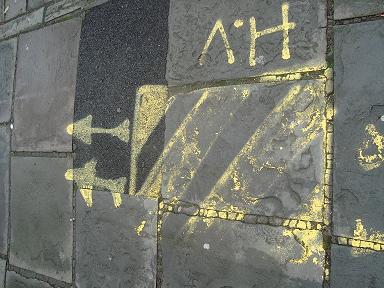
Much pennant paving has already gone but how can the utility companies get away with this tarmac bodge

This image was sent to me- the only tarmac in the whole of Dowry Square. This was happily and speedily resolved
Can you advise me to whom I should complain to have it replaced with stone in keeping with the rest of the pavement?
Customer.Services@bristolwater.co.uk responded
Thank you for your email as below, this was passed to us at Bristol Water Customer Services as we are responsible for the work carried out in Dowry Square. I understand that the cover in question was reported as a dangerous trip hazard ; as the lid was proud of the pavement. It was therefore repaired as quickly as possible and a temporary reinstatement was made to make the area safe. We will be returning to Dowry Square within the next 7 working days to carry out a full and final reinstatement with pennant slabs, barring any operational emergencies.
For future reference, our Code of Practice for Enquiries and Complaints can be found on our website - http://www.bristolwater.co.uk/ If you have any other questions about this e-mail please contact me on 0845 7023797, 8.30am to 4.30pm Monday to Friday, or through our e-mail address Customer.services@bristolwater.co.uk.
Pennant Flagstones

The bottom of Sion Hill and round the corner of Caledonia Place has had flagging replaced. This is great because Caledonia Place had tarmac before
PETITION - FOOTWAY MATERIALS PRINCESS VICTORIA STREET. CLIFTON
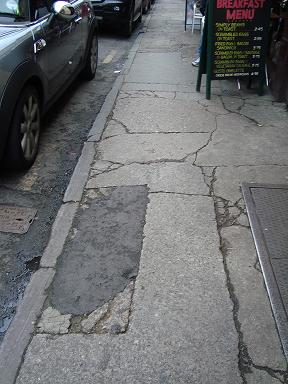
2012: Finally, flagstones were laid
6 December 07: The Council plan to have 6pm - 10pm, Monday 18 & Tuesday 19 December 'Light Up Bristol' lights show on The Council House & surrounds, College Green. This will cost £40,000. If they can afford this, then why can they not afford £28,000 for pennant stone paving in Clifton?
10 Sept 07: CHIS is hoping to get better quality pavings laid in Princess Victoria Street. The Council removed fine pennant stone from here in the 1970's and we feel that, as a historic conservation area and major tourist destination, Clifton deserves better than the cheapest possible option.
Response from Councillor Mark Bradshaw, 24th August
Your petition regarding the choice of materials to be used on the proposed reconstruction of the footways in Princess Victoria Street
has been received by the Council and the issues raised in it have been investigated. The subject of footway materials is a difficult one
that prompts discussions throughout the city. The Council have to balance the competing priorities of complying with its Statutory duties
and achieving-a- pleasant environment within its recourses.
The footways in Princess Victoria Street are in a poor condition and have to be replaced. To do this in Pennant stone as requested in the
petition will result in significant additional cost and result in the Council not being able to undertake other necessary footway works.
The appearance of the proposed materials is not dissimilar to other roads in the area and complies with the policy of replacing footways
with similar materials.
I therefore propose to continue with the installation of the small concrete slabs on this footway to achieve a safe and consistent
walking surface. I note that officers have
discussed this issue with you and whilst agreement could not be reached in this case, I hope that we will continue to discuss
issues to reach agreement if possible.
Yours sincerely,
Councillor Mark Bradshaw,
Executive Member for Access & Environment,
The Council House College Green Bristol BSI 5TR
CHIS is most unhappy about this response and hopes to reverse this decision. Please respond to Mark Bradshaw if you feel able (0117 9037968 or email mark.bradshaw@bristol.gov.uk), and let us know.
Cobbles and flag stones

Cobbles are a feature of most of Bristol guttering
Boyce's Avenue has had its cobbles guttering replaced very nicely!
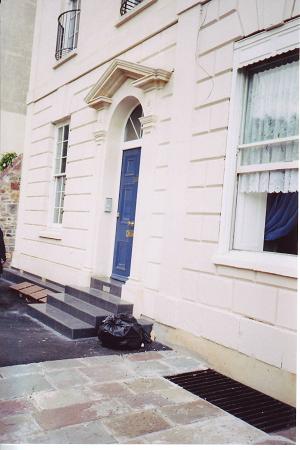
A totally new house on the raised Georgian terrace in Hotwell Road built faithfully and beautifully in the style of its neighbours is marred by tarmac instead of paving stones outside
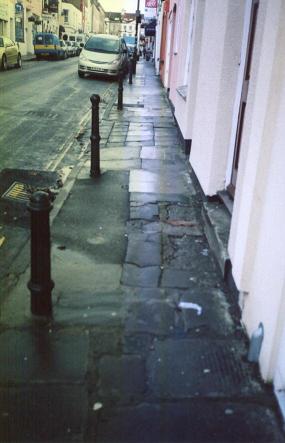
Broken paving in Princess Victoria Street
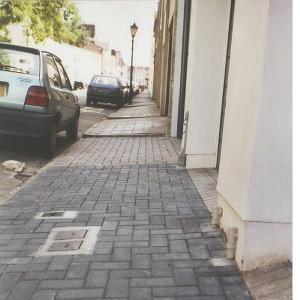
Seven houses have just been built in Princess Victoria Street. The developer replaced the paving slabs with zigzag small blocks which do not match the rest of the street, and are badly laid.
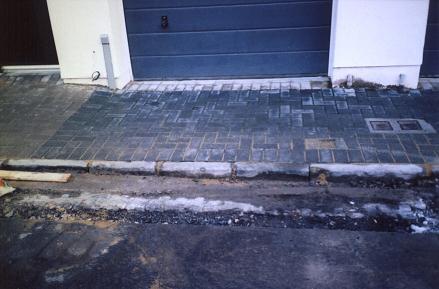
long kerbing stones so that drainage water runs down the road rather than pavement!
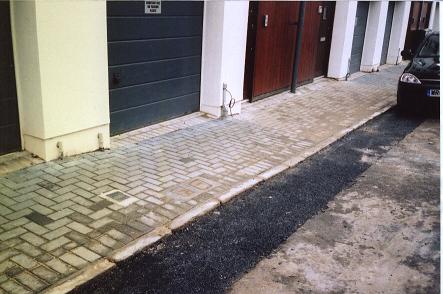
Better, but road still messy. Why could they not learn from the guys relaying Boyces Avenue gutter, St Michaels Hill, and Sion Hill?
Jan 2005- the kerbs are now being lifted, and changed from small cobbles
Features which need to be protected
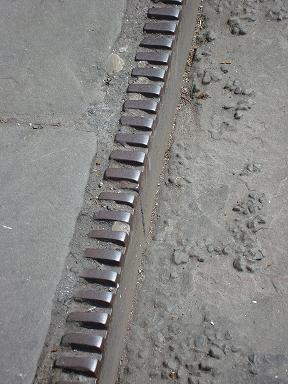
iron protection of kerbs from carts |

iron protection on corner |
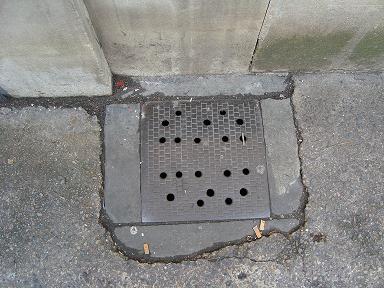
coal hole covers |

inspection covers |
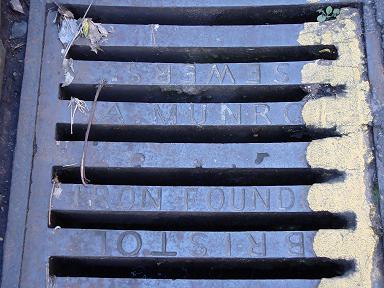
drain covers |

unusual pennant jigsaw paving |
Useful websites:
- Streetscape in a conservation area. Excellent article from the Building Conservation Directory 1996.
-
Bristol City Council Use A-Z to find
roads and pavements, fly posting, prominent satellite dishes.
Call 0117 922 3838 about:
- Manhole covers
- Pavements
- Roads
- Kerbs
- Street nameplates
- Bollards
- Overhanging trees and shrubs
- Obstructions
- Spillages
- Roadworks in Bristol
